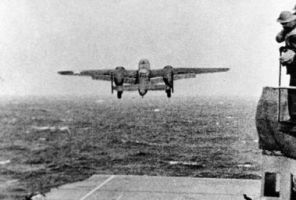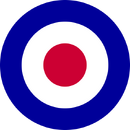The Doolittle Raid was an ambitious air raid launched by the United States against Japan, on April 18, 1942
Description[]
The mission involved sixteen B-25 Mitchell bombers lead by James Doolittle taking off from the aircraft carrier USS Hornet (CV-8),[N 1] while in close proximity to the Japanese mainland and bombing targets including Tokyo and Yokohama.[3] While resulting in almost all aircraft crashing and several participants dying or being captured, the raid was considered a success, as it boosted the moral of the American public and shook Japan's confidence.
Planning and Preparation[]
The proposal for a raid to boost US morale, and serve as retaliation for the Bombing of Pearl Harbor, came from Captain Francis Low, a submarine officer serving under Admiral Ernest King, the future Chief of Naval Operations.[N 2] Low suggested adapting the already approved idea of launching USAAC fighters from the decks of aircraft carriers, by using medium bombers in place of fighters. The suggestion reached the desk of General 'Hap' Arnold, who passed it to his special projects officer, Lt Colonel James Doolittle.[6]

A B-25 taking off.
Doolittle selected the B-25 Mitchell for the operation, ahead of the B-26 Marauder, because of the B-25's better take off performance. Doolittle's plan called for 20 B-25's to launch from USS Hornet, 400 miles from the target, before flying west to refueling points in China. After refueling, the aircraft would travel to Burma, with the intention of Joining the forces of General Stilwell in the CBI theatre.[6] To increase the range of the aircraft, the ventral turret was replaced with extra fuel tankage, increasing the total carried to 1,141 gallons. The aircraft were further modified, by having the secret Norden bomb sight replaced with a temporary low-level version, primarily because the bombs would be dropped from 1,500 ft, and a pair of black painted broom handles in the tail position in place of guns.[2]
Training[]
Training was undertaken at Eglin Field, using 24 B-25Bs and volunteer crews taken from the 17th Bomb Group.[N 3] Without knowing the exact nature of the mission they were training for, the crews that volunteered repeatedly practiced the art of short take-offs, with all of them mastering the art of leaving the ground within 450 ft.[6]
The Raid[]
On April 1, 1942, a force of 16 modified B-25Bs were loaded aboard Hornet, which set sail for Japan the following day.[6] However, on April 18 the aircraft were forced to take off ten hours ahead of schedule, while still at least 700 miles from the target, after Hornet was spotted by a Japanese picket vessel. The ship was sunk by the Hornet's escorting cruisers and destroyers, but not before it sent an attack warning to Japan. Some of the aircraft arrived over Tokyo during an air raid practice. only one aircraft was hit by anti-aircraft fire, suffering minor damage.[7] Eight aircraft bombed their primary targets, with another five hitting secondary targets.[7] As the early take off prevented the B-25s reaching safety in China, eleven crews bailed out and four others crashed landed. The remaining aircraft, 40-2242, and it's crew were interned by the Russians after landing at Vladivostok.[6]
Aftermath[]
Doolittle expected to be court martialled on his return, as he believed the raid had been a disaster. However, the value of the raid in raising moral far outweighed the actual damage caused. In addition, the attack forced the Japanese to recognise their vulnerability to air attack, prompting them to retain four fighter units, which had been intended for service in the Solomon Islands, to protect the Home Islands.[6] Doolittle himself was promoted from Lieutenant Colonel to Brigadier General, and awarded the Congressional Medal of Honor.[8]
The Doolittle Raid proved to be the only US air attack against Japan until 15 June 1944, when 50 B-29s from the 58th Bombardment Wing (VH) carried out a night raid against the steel mills at Yawata, with the loss of seven aircraft.[9]
Notes[]
- ↑ Referred to by President Roosevelt as 'Shangri-La'.[2]
- ↑ King was head of the Atlantic Fleet at this point.[4] He was not appointed as Chief of Naval Operations until March 27th 1942, by which time the final preparations for the raid were almost complete.[5]
- ↑ The crews were joined by personnel from the 89th Reconnaissance Squadron.[2]
References[]
- ↑ http://www.ibiblio.org/hyperwar/AAF/rep/Doolittle/Report.html
- ↑ 2.0 2.1 2.2 Green, William. Famous Bombers of the Second World War. Purnell Book Services. 1975. Page 24
- ↑ http://www.history.navy.mil/photos/events/wwii-pac/misc-42/dooltl.htm
- ↑ Goralski, Robert. World War II Almanac 1931-1945. Hamish Hamilton Ltd. 1981. ISBN 0 241 10573 0 Page 146
- ↑ Goralski, Robert. Page 210
- ↑ 6.0 6.1 6.2 6.3 6.4 6.5 Aeroplane Magazine Database section May 2013. Page 80
- ↑ 7.0 7.1 Goralski, Robert. Page 212
- ↑ World Aircraft Information Files Aviation Partwork. Midsummer Books Ltd. File 394 Sheet 5 (Military Leaders and Tacticians: 'Jimmy' Doolittle)
- ↑ Green, William - Bombers. Page 82
| |||||||||||||||||

